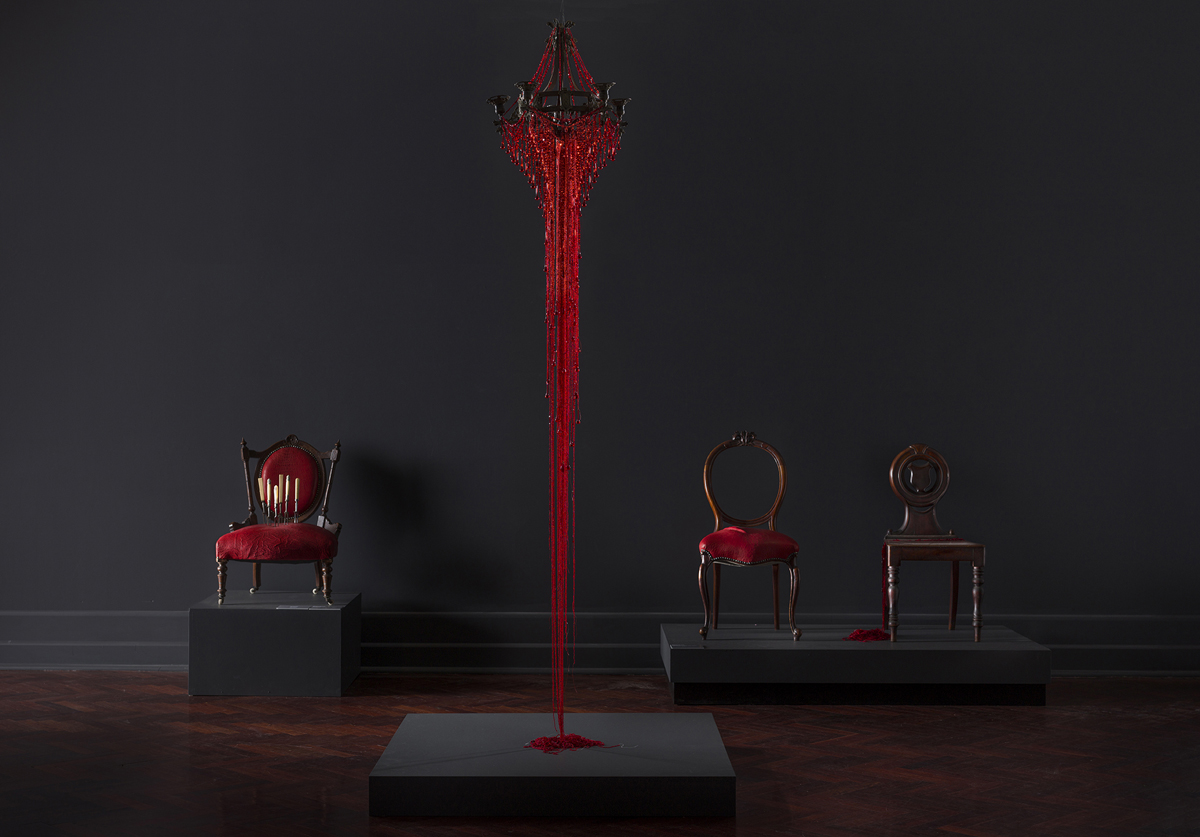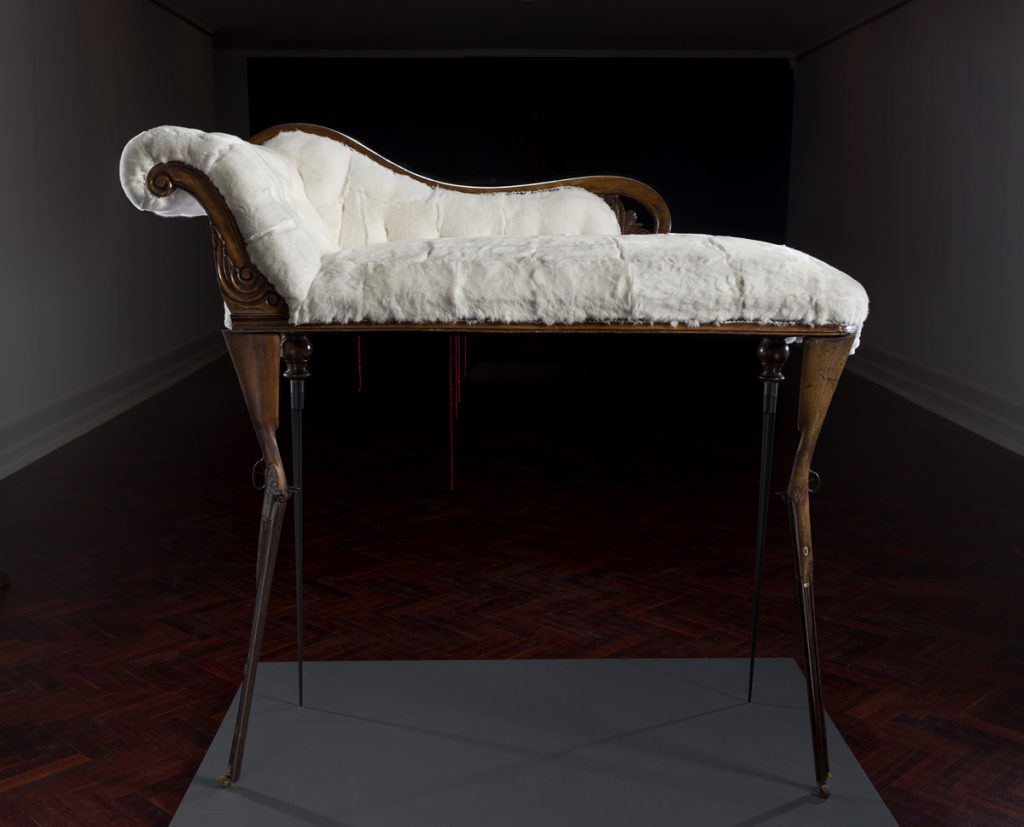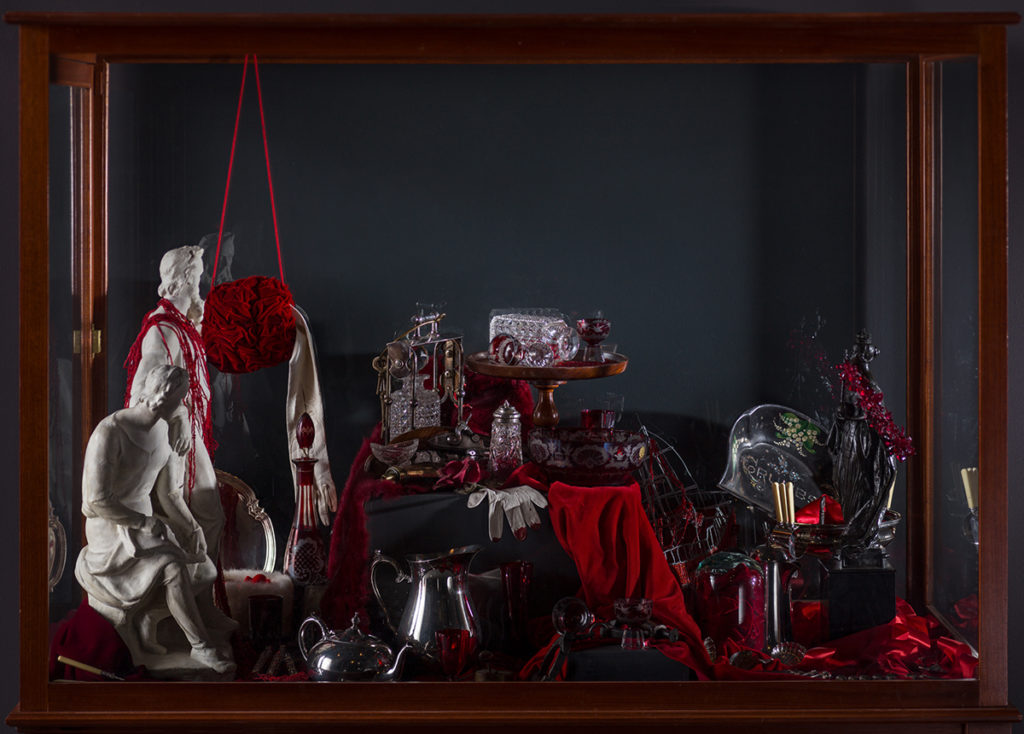Megan Evans, Owning her Colonial Past

image above: Megan Evans, Bleeding Chandelier, 2017, Squatters and Savages exhibition installation at the Art Gallery of Ballarat, photograph by Mathew Stanton
*Acknowledgement of country at bottom of page due to length
Megan Evans is an interdisciplinary artist who through her work, has been wiping away the fog of delusion about her white Australian colonial identity. Evans’ work explores privilege, oppression and the impacts of colonisation on our First Nations people, who have maintained 70,000+ years of continuous Culture and History in this country. In works that combine an aesthetic both beautiful and macabre, Evans brings attention to the everyday violence and oppression contained within objects of whiteness. A chair drenched in red and slashed open bears witness to colonial heritage and in its universality speaks to the many acts of sitting upon, reigning and claiming ownership over, with the raw underbelly of violence clear to be seen. Art World Women’s Claire Bridge speaks with Megan Evans about her practice and process.
AAW: You describe yourself as an artist whose work is informed by social issues. Do you see art as a force for social change and what changes in particular do you hope to see?
Evans: In my most idealistic moments I see art as something that can change the world. It impacts people at the level of their unconscious so you can alter the way they see things without them even knowing. I see things in the world differently, or notice things that would have otherwise been invisible to me as a result of the work of artists and the way they have impacted me. I have to believe this as I am only an artist but I do want to make a difference and I long ago gave up any delusions that I might be a politician or a serious full time activist.
When I did the Northcote Koorie Mural over 30 years ago Northcote was a racist place. People wrote “shoot blacks” across the wall. Last week in the Northcote bi-election, the first Aboriginal woman was elected into State Parliament so something has changed and I hope the mural standing there for over 30 years contributed to that.
AWW: What does colonial identity mean to you personally and as an artist? How do you explore this in relation to the historical and continuing impact of colonisation on Indigenous people?
Evans: Colonial identity is something I have named to try to describe the coloniality that invades everything in our current society from the way we structure our education, prison and health systems to the basis of our economics. I learned so much from my involvement in the Aboriginal community at a very formative time in my life, my early 20’s & 30’s. Then I married an Aboriginal man and became a part of a large extended family. This taught me to always be aware of how my thinking is shaped by my colonial heritage. I can’t escape it, I can only acknowledge it. This informs my work and I am finally dealing with it in my work after many years of trying to avoid the personal confront of these issues. So now the work I am doing is distinguishing for me, how and where this influences my daily actions and thought processes.
I have always been drawn to the aesthetic of the colonial era, especially the beauty of Victoriana, however in the past I rejected it because I wanted to belong to something that didn’t have such a dreadful history of theft and violence. I knew I couldn’t belong to Indigenous cultures as that would have been further appropriation but I couldn’t find who or what I was culturally. Owning my colonial heritage is both a personal and political act as it is about taking responsibility for something I hadn’t wanted to be responsible for but at the same time it has also led me to know who I am, where I come from and begin to accept it.

AWW: How has doing artists’ residencies influenced your work and you as an artist?
Evans: Doing residencies has been enormously important to me. My first major residency was an Australia Council residency to Liverpool in the UK. It was for three months with a stipend, a studio and a flat. I was the happiest I have been in my whole life.
All I had to do was think, breath and sleep my work. It was also important as I was able to research my Irish and Scottish ancestry and begin to understand where my people had come from.
AWW: Collaboration has been a large part of how you’ve worked throughout your career across a variety of projects. What have been some of the highlights and pitfalls of working in collaboration?
Collaboration is when two people come together on equal terms and create something together that neither of them would have done on their own. Taking into account the unequal place that Indigenous and non-Indigenous people hold in the power base of our society I don’t think we can come together on equal terms as yet.
Evans: I have collaborated a lot with Indigenous artists over many years which has been a rich experience, however I now think that given the history of Australia and how whiteness and white privilege plays out, it is too soon for real collaboration that way. I mostly took the back seat and was led by the Indigenous artists in those collaborations and because of that my own perspective – the colonial view didn’t come to the fore. I held it in check and the aesthetic that I am now engaged in wasn’t present. That’s not to take away from the work we did together but I would now say it wasn’t true collaboration.
Collaboration is when two people come together on equal terms and create something together that neither of them would have done on their own. Taking into account the unequal place that Indigenous and non-Indigenous people hold in the power base of our society I don’t think we can come together on equal terms as yet.
To have integrity the non-Indigenous artist must step back and allow more voice to the Indigenous artist. I was invited by Peter Waples-Crowe (Ngarigo) to work with him on an exhibition responding to the Art Gallery of Ballarat’s colonial print collection. This was a wonderful opportunity to develop a new way to collaborate. We decided to work separately but collaborate conceptually and the result was probably the best exhibition I have ever been involved with – SQUATTERS AND SAVAGES.
The work I do now is for the possibility of the day when we can all own the rich 70,000 plus history of human occupation in this country, however this requires justice for Indigenous people which means their self determination on all fronts, land justice, recognition of and restitution for the brutality of the past. The fact that hasn’t been achieved yet is a white problem and I think we have a responsibility to deal with it.

AWW: You have worked independently of the commercial gallery system. What are some of the benefits of being an independent artist?
Evans: To be honest I have worked independently as an artist because I haven’t found a commercial gallery willing to take me on. I am not opposed to being represented, however my work isn’t exactly seen as saleable by many gallerists. I have been working towards developing a reputation by showing in artist run spaces and public galleries in the hope to build enough profile that my work will become collectable. I have recently been collected by a major collector, which was fabulous, however I can see that if I had a gallery representing me there would be more opportunities for serious collectors to be exposed to my work.
Over the years I have had many people say to me if I just painted ‘such and such’ I could sell, but unfortunately I haven’t been able to do that. The soul would go out of my work, which I know sounds pretentious but it is a fact. It would just become a job and I think you can get better paintings at Ikea than I would do if that was the motivation behind my work.
AWW: As a interdisciplinary artist, you work across video, installation, painting, sculpture, text and recently with music and sound collaborations. To what extent does materiality influence your work and what you wish to convey?
Evans: I was fortunate to do a Bachelor of Education Arts and Crafts at Melbourne State College in the days when a full time art course was 8 hrs a day 5 days a week. In that course I was exposed to every kind of medium possible from dress making to gold and silver smithing. While I became a ‘jack of all trades and a master of none’, over the years it has been the best training I could have for a contemporary artist at a time when everything is possible. The mediums I use are decided by the concepts and ideas I am exploring.
I have recently learned to embroider for the first time and have been doing it in a way that is probably unconventional, however the training gave me the courage to try anything from performance to hard core realism drawing. The materiality of the work I am doing now is very relevant because I am intervening in Victorian objects and using the very things that either represent, or were, the objects of oppression.

AWW: I’ve noticed that red ribbons have appeared in your work for over 20 years. What symbolism reoccurs for you in your work and what messages have you found they are communicating to you or you are communicating by them?
Evans: My use of red ribbons came before they were used to represented the Aids battle in 1991. I first used them in 1990 when I was doing my masters at the VCA on a painting about my brother who had died of an overdose. They always represented blood lines and connections to ancestry and the past. They have transformed into red beads recently which is even more blood like, however they still carry the same meaning. In the context of colonisation they have both an ancestral association and a reference to the violence of the Victorian era which is what I am currently confronting in my work.
AWW: What projects are you working on at the moment?
The effects of colonisation has laid a blanket of white over the world, which we are all judged and oppressed by, but it particularly disallows the voices and pride of people of colour to contribute their unique perspective to a world that represents all.
Evans: I am still working on a long term project titled the KELOID project. It has included five stages – Stage 1 – REVEAL, Stage 2 – UNsettling, Stage 3 – UNreconciled, Stage 4 – SQUATTERS and SAVAGES, and Stage 5 – Curious Cabinets.
Each of these exhibitions are part of the unfolding of an enquiry into healing the past by taking responsibility for actions and attitudes of whiteness and white privilege. A keloid is variously defined as both the unsightly scar from the healing of a wound AND a sign of initiation or significant life event. This is my lifetime project I think. It will never be resolved but it is pursuing an awakening of whiteness in all its layered forms such that other values and ways of being are equally respected and honoured in the world. The effects of colonisation has laid a blanket of white over the world, which we are all judged and oppressed by, but it particularly disallows the voices and pride of people of colour to contribute their unique perspective to a world that represents all.
The work I am doing at the moment is particularly focused on my own ancestry placed squarely in Australia, however this is a global project in essence.
I am hoping to collaborate more in the new way I have developed of working, with Indigenous artists and People of Colour. I think working alongside these artists just adds to what I am trying to express by providing the other side of the frontier of colonisation and whiteness. Watch this space as I have some other powerful possibilities for collaboration with some incredible people in the pipeline.

I acknowledge
That I live on the sacred land of the Wadawurrung.
I acknowledge that I am an occupier.
I acknowledge that although I was born here,
I come from a history of occupiers
Who have yet to reconcile
with the people or the land they have occupied.
I acknowledge
that my ancestors
with ignorance, insensitivity
and brutality,
illegally occupied the land
of the Wurrundjerri, the Wongaibon and the Yaitmatang peoples
I acknowledge
that I grew up
treading on the sacred land
of the Kulin nation,
without knowledge or awareness,
blind to my cultures damage
to the First Nations people.
I acknowledge
That in my adult years
I have arrogantly thought
I knew better,
blind to my white privilege
spoke over my black brothers and sisters.
I acknowledge
that my success
is built on the struggle
of dispossessed others.
I acknowledge
that as yet, my culture continues
to deny this fact
and remains blind
to the effects of colonisation
and intergenerational trauma
on Aboriginal people
to this day.
I acknowledge
that the pain, grief and loss
of land and language
that my culture is responsible for
is reflected in our countries
identity.
I acknowledge
and take responsibility
for my peoples ignorance,
racism and cruelty.
On behalf of myself and my ancestors,
I offer my heartfelt apology.
I commit
to being open and humble
and always respecting the knowledge and wisdom
of the first peoples of this land.
I stand for a future of shared mutual respect and partnership
with Indigenous peoples of this country and the world.
~ Megan Evans
MEGAN EVANS
@megaevans
www.meganevansartist.com
Well written you had to get it out your inner feelings.